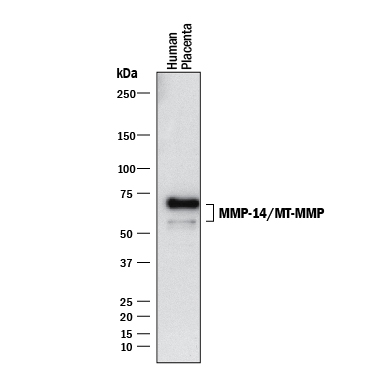Human MMP-14/MT1-MMP Antibody Summary
Applications
Please Note: Optimal dilutions should be determined by each laboratory for each application. General Protocols are available in the Technical Information section on our website.
Scientific Data
 View Larger
View Larger
Detection of Human MMP‑14/MT1‑MMP by Western Blot. Western blot shows lysates of human placenta tissue. PVDF membrane was probed with 2 µg/mL of Mouse Anti-Human MMP-14/MT1-MMP Monoclonal Antibody (Catalog # MAB918) followed by HRP-conjugated Anti-Mouse IgG Secondary Antibody (Catalog # HAF018). Specific bands were detected for MMP-14/MT1-MMP at approximately 50 kDa and 62 kDa (as indicated). This experiment was conducted under reducing conditions and using Immunoblot Buffer Group 1.
 View Larger
View Larger
MMP‑14 in Human Benign Nodular Hyperplasia. MMP-14 was detected in immersion fixed paraffin-embedded sections of human benign nodular hyperplasia using 25 µg/mL Mouse Anti-Human MMP-14 Monoclonal Antibody (Catalog # MAB918) overnight at 4 °C. Tissue was stained with the Anti-Mouse HRP-AEC Cell & Tissue Staining Kit (red; Catalog # CTS003) and counterstained with hematoxylin (blue). View our protocol for Chromogenic IHC Staining of Paraffin-embedded Tissue Sections.
Reconstitution Calculator
Preparation and Storage
- 12 months from date of receipt, -20 to -70 degreesC as supplied. 1 month, 2 to 8 degreesC under sterile conditions after reconstitution. 6 months, -20 to -70 degreesC under sterile conditions after reconstitution.
Background: MMP-14/MT1-MMP
As the first member of membrane type (MT) MMPs, MMP-14, also known as MT1-MMP, plays an important role in extracellular matrix (ECM) remodeling by being able to degrade type I collagen, activate pro-MMP-2 and process cell adhesion molecules such as CD44 and Integrin alpha V (1). MMP-14 is therefore a key enzyme in many physiological and pathological processes such as angiogenesis and tumor invasion. Structurally, MMP-14 consists of the following domains: a pro domain containing the furin cleavage site, a catalytic domain containing the zinc-binding site, a hinge region, a hemopexin-like domain, a transmembrane domain, and a cytoplamasic tail (2).
Product Datasheets
Citations for Human MMP-14/MT1-MMP Antibody
R&D Systems personnel manually curate a database that contains references using R&D Systems products. The data collected includes not only links to publications in PubMed, but also provides information about sample types, species, and experimental conditions.
3
Citations: Showing 1 - 3
Filter your results:
Filter by:
-
Selective blockade of matrix metalloprotease-14 with a monoclonal antibody abrogates invasion, angiogenesis, and tumor growth in ovarian cancer.
Authors: Kaimal R, Aljumaily R, Tressel S, Pradhan R, Covic L, Kuliopulos A, Zarwan C, Kim Y, Sharifi S, Agarwal A
Cancer Res, 2013-02-19;73(8):2457-67.
Species: Human
Sample Types: Serum
Applications: Western Blot -
Laminin-111 derived peptides AG73 and C16 regulate invadopodia activity of a human adenoid cystic carcinoma cell line.
Authors: Nascimento C, de Siqueira A, Pinheiro J, Freitas V, Jaeger R
Exp Cell Res, 2011-09-07;317(18):2562-72.
Species: Human
Sample Types: Whole Cells
Applications: ICC -
Hyaluronic acid and thrombin upregulate MT1-MMP through PI3K and Rac-1 signaling and prime the homing-related responses of cord blood hematopoietic stem/progenitor cells.
Authors: Shirvaikar N, Marquez-Curtis LA, Ratajczak MZ, Janowska-Wieczorek A
Stem Cells Dev., 2010-10-25;20(0):19-30.
Species: Human
Sample Types: Whole Cells
Applications: ICC
FAQs
No product specific FAQs exist for this product, however you may
View all Antibody FAQsReviews for Human MMP-14/MT1-MMP Antibody
There are currently no reviews for this product. Be the first to review Human MMP-14/MT1-MMP Antibody and earn rewards!
Have you used Human MMP-14/MT1-MMP Antibody?
Submit a review and receive an Amazon gift card.
$25/€18/£15/$25CAN/¥75 Yuan/¥2500 Yen for a review with an image
$10/€7/£6/$10 CAD/¥70 Yuan/¥1110 Yen for a review without an image

